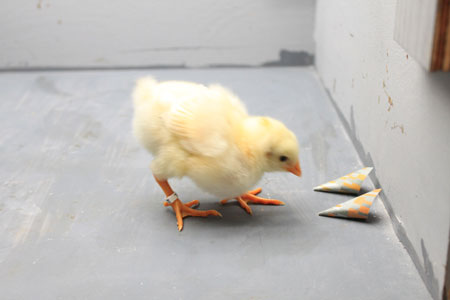Birds are colourful and they use colour for communication, finding food and other tasks. Not surprisingly, their eyes have specific adaptations for colour vision: four types of cones sensitive to ultraviolet (or violet), blue, green and red light. Oil droplets, pigment-filled organelles in each of these cones, act as lenses and spectral filters, they narrow the spectral sensitivity of the cones. This is thought to improve colour discrimination, but how does this affect bird vision in dimmer light? Do birds lose colour vision earlier than humans?

Figure: A chicken just before making a colour choice in bright light.
A recently concluded HFSP grant awarded to Joseph Corbo, Nicholas Roberts and Almut Kelber and their research groups has enabled these questions to be answered. This was possible as the HFSP-team combined expertise in optics, molecular biology of the retina, and bird visual behavior. First, it turned out that oil droplets filled with carotenoid pigments (Toomey et al 2016) reduced the sensitivity of the cones (Wilby et al 2015). While clear oil droplets have the potential to act as micro-lenses and increase the number of photons reaching the light-absorbing outer segments of the photoreceptors, light absorption by the pigments strongly counteracts this, leading to a sensitivity loss. This is not a problem in bright light. Indeed, with enough light available, chickens can detect as small differences in colour as humans. Asked to make choices in lower and lower light intensities, however, the birds fail earlier than humans (Olsson et al 2015).
In dim light, the random arrival of photons at each cone starts causing problems for vision. If 100 photons are reflected from a colour patch and reach a cone on average each second, the exact number could be 100±10 (the square root of 100), but for an average of 1 photon arriving each second, it could be 2 or 0 – making the detection of the colour patch uncertain. This so-called photon shot noise sets one of the limits of colour discrimination. If the animal could use 100 cones to look at that colour patch, and pool the information from these 100 cones, that would average out the photon shot noise, and again allow for a reliable colour vision.
To find out whether chickens can indeed pool signals from multiple cones, they were tested with colour patches of different sizes (Olsson et al 2017). The chickens learned to choose between two food cones covered with colour and grey tiles. Asked to discriminate between two food cones fully covered with yellow and orange (or two green and turquoise) tiles, they had no problems even in dim light. Even food cones with a large (6 x 6 mm) colour tile among multiple grey tiles posed no problem. However, when confronted with food cones that had a single small colour tile (3 x 3 mm), or only 10% colour tiles among grey tiles, they failed to discriminate in much higher light intensities. This strongly indicates that the chickens can spatially pool information from multiple cones for reliable colour discrimination. Although further experiments are needed to understand the underlying visual processing, the results fit with predictions from optical models of the cones with oil droplets.
Reference
[1] Spatial summation improves bird colour vision in low light intensities. Olsson, P., Wilby, D. & Kelber, A. (2017) Vision Research 130, 1 – 8. (doi: http://dx.doi.org/10.1016/j.visres.2016.10.009)
Other References
[2] Bird colour vision: Behavioural thresholds reveal underlying receptor noise. Olsson, P., Lind, O. & Kelber, A. (2015) J. Exp. Biol. 218, 184 – 193. (doi: http://dx.doi.org/10.1242/jeb.111187).
[3] Complementary shifts in photoreceptor spectral tuning unlock the full adaptive potential of ultraviolet vision in birds. Toomey, M. B, Lind, O., Frederiksen, R., Curley, R. W., Riedl, K. M., Wilby, D., Schwartz, S. J., Witt, C. C., Harrison, E. A., Roberts, N. W., Vorobyev, M., McGraw, K. J., Cornwall, M. C., Kelber, A., & Corbo, J. C. (2016) ELife 5, e15675. (doi: http://dx.doi.org/10.7554/eLife.15675).
[4] Optics of cone photoreceptors in the chicken (Gallus gallus domesticus). Wilby, D., Toomey, M. B., Olsson, P., Frederiksen, R., Cornwall, M. C., Oulton, R., Kelber, A., Corbo, J. C. & Roberts, N. W. (2015) J. R. Soc. Interface, 12, 20150591. (doi: http://dx.doi.org/10.1098/rsif.2015.0591).


































